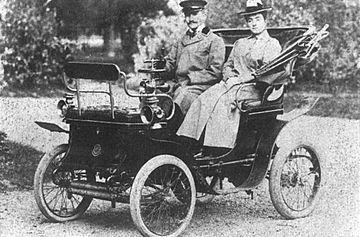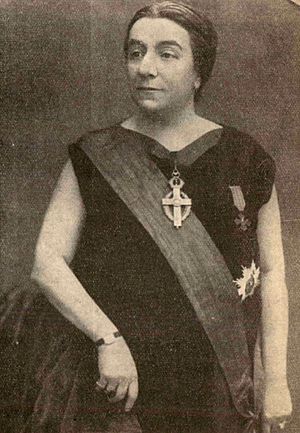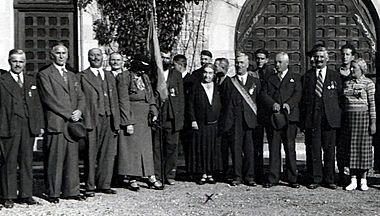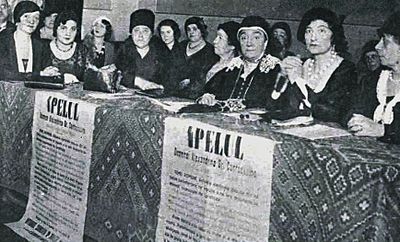Alexandrina Cantacuzino facts for kids
Quick facts for kids
Alexandrina Cantacuzino
|
|
|---|---|

Cantacuzino, photographed ca. 1925
|
|
| Vice President of the International Council of Women | |
| In office 1925–1936 |
|
| Delegate of the Kingdom of Romania to the League of Nations | |
| In office 1929–1938 |
|
| Personal details | |
| Born |
Alexandrina Pallady
September 20, 1876 Ciocănești, Dâmbovița County (formerly Ilfov County) |
| Died | late 1944 (aged 67 or 68) |
| Nationality | Romanian |
| Political party | Iron Guard |
| Spouse | Grigore Gheorghe Cantacuzino (widowed 1930) |
| Children | Gheorghe Cantacuzino (died 1977) Alexandru "Alecu" Cantacuzino (died 1939) |
| Distinctions | Meritul Cultural Order of Queen Marie Order of the Holy Sepulchre Order of St. Sava Croix de guerre Croce al Merito di Guerra |
| Nickname | Didina Cantacuzino |
Alexandrina "Didina" Cantacuzino (born Alexandrina Pallady, September 20, 1876 – late 1944) was an important Romanian activist, helper, and diplomat. She was one of the leading voices for women's rights in Romania during the 1920s and 1930s.
She led groups like the National Council of Romanian Women. She also served as Vice President of the International Council of Women. She represented Romania at the League of Nations, an organization that worked for world peace. However, her strong beliefs about her country and her support for certain ideas, like eugenics (a harmful idea about improving the human race), later led her to support more authoritarian political groups.
Alexandrina Cantacuzino came from a noble Romanian family. After marrying a wealthy landowner, Grigore Gheorghe Cantacuzino, she used the title "Princess." She believed that upper-class people had a special role to help society. After World War I, she became president of a charity called SONFR. She was a nurse during the war and helped remember those who died. She also supported women getting the right to vote, but only for certain women. This caused her to lose support from some women's rights groups. Later, her ideas became similar to those of fascist governments during World War II.
She supported the Iron Guard, a revolutionary fascist group, and her son Alecu was also part of it. In 1941, she switched her support to Ion Antonescu's government. She had reported to the League of Nations about the damage from the Spanish Civil War. She also spoke out against Antonescu after the 1941 Odessa massacre. Alexandrina Cantacuzino died in late 1944, not long after Antonescu's government fell.
Contents
Biography
Early Life and Family Background
Alexandrina Pallady, also called Didina, was born on September 20, 1876. She was born in Ciocănești, a village in what is now Dâmbovița County. Her family, the Palladys, were part of the upper class in Romania. Her father, Theodor Pallady, was a military officer. Her mother, also named Alexandrina, came from another noble family, the Kretzulescus.
Alexandrina was the only one of her parents' four children to survive past infancy. She also had a half-brother, Alexandru Teodor "Al. T." Stamatiad, who became a poet. Other famous relatives included the painter Theodor Iancu Pallady and the actress Lucia Sturdza-Bulandra.
When her mother died, Alexandrina was five years old. Her aunt, Eliza Ghica, raised her and formally adopted her. With money from the Ghica family, Alexandrina studied in France. Around 1899, she married Grigore Gheorghe Cantacuzino in Bucharest. He was an aspiring politician. Her full name became Alexandrina Grigore Cantacuzino.
Her marriage brought her into high society. The Cantacuzino family was very powerful in Romanian politics. Her father-in-law, Gheorghe Grigore Cantacuzino, was a former Prime Minister. He was also one of the richest landowners in Romania. The Cantacuzinos claimed a princely title. This allowed Alexandrina to call herself "Princess Cantacuzino." She loved collecting titles and studying her family history. Her family was so wealthy they owned one of Bucharest's first private cars.
Joining SONFR and Early Activism
Alexandrina and Grigore had three sons between 1900 and 1905. In 1910, Alexandrina joined the National Orthodox Society of Romanian Women (SONFR). This was a charity group linked to the Romanian Orthodox Church. She is often called a founding member.
SONFR was made up of high-society women. It focused on traditional roles for women as mothers and wives. The group was not political at first. However, it soon started projects like spreading information among Romanians in other parts of Europe. They also protested against efforts to make Romanians speak Hungarian.
SONFR received money from wealthy families and bank loans. They used these funds to open two girls' schools, 17 kindergartens, and 22 public libraries. They also bought land for Romanian farmers in other regions.
SONFR's main goal was to fight against "foreign religious propaganda." They believed this was corrupting young Romanian women. Historians say this showed the group's strong support for Romanian Orthodoxy. They also used the Church's network to spread their message.
Some SONFR members were liberal women who supported women's right to vote. Alexandrina Cantacuzino called herself a "feminist." But she was mainly an elitist. She believed that the upper classes had a "historic mission" to help the country. She wanted to help disadvantaged people to serve the nation.
In 1913, her husband Grigore became the Mayor of Bucharest. This was thanks to his powerful father. The large Cantacuzino family estate was divided between Grigore and his brother. The Cantacuzino Castle in Bușteni became a frequent retreat for the Romanian royal family. In 1915, Alexandrina also inherited her adoptive father's properties.
A Nurse During World War I
When World War I started in 1914, Romania remained neutral at first. Public opinion was divided between supporting the Entente Powers (like France and Britain) or the Central Powers (like Germany). Grigore Cantacuzino's newspapers were linked to German supporters.
In 1916, Romania joined the war on the side of the Entente. Alexandrina volunteered as a nurse. In August 1916, she became the manager of Hospital No. 113 in Bucharest. By the end of the year, the German army was approaching Bucharest. The King and government retreated to Moldavia. This divided the Cantacuzino family. Some stayed in Bucharest and worked with the German regime. Others remained loyal to the King. The Zamora Castle was taken over by the German Army.
Grigore worked with the German-backed administration in Bucharest. He also helped get firewood for the people of Bucharest. Alexandrina became a member of the Red Cross "Ladies' Committee." She helped provide aid for prisoners of war. She believed that "a new world shall rise from the bloodied humanity." This meant she trusted in the Romanian people's ability to work and renew themselves.
Alexandrina often stood up to the German authorities to protect SONFR's interests. SONFR helped smuggle recovering Romanian soldiers back to the free zone in Moldavia. The Germans evicted her hospital, and Alexandrina protested. She and her husband also spoke up for the Metropolitan Bishop, Conon, who was being pressured by the Germans. These acts of defiance almost led to Alexandrina's imprisonment.
After the War: SONFR President
In 1918, the war ended with the Entente Powers winning. Alexandrina Cantacuzino was elected SONFR president. She led the Society until 1938.
Some people, like Sabina Cantacuzino (her sister-in-law), criticized Alexandrina. They said she was just putting on a show of compassion for Romanian soldiers. They claimed she knew her husband was favored by the Germans. These criticisms were published in memoirs.
After the war, the Conservative Party was in trouble. Alexandrina's husband, Grigore, wanted to reform it. He and other landowners were against land reform. They wanted the party to keep representing landowners' interests.
Leading Women's Rights Groups
After Greater Romania was formed, SONFR started working with other women's groups. Alexandrina became a member of the Association for the Civil and Political Emancipation of Romanian Women (AECPFR). In 1921, she became Vice President of the new National Council of Romanian Women (CNFR). Around 1923, she argued for women's right to vote. She criticized the new constitution for not including it.
During these years, Cantacuzino lectured about Orthodox and nationalist values. She attracted many middle-class women to SONFR. She believed that the "new world" after the war meant the end of "doll-like women." She wanted women to be "mother-citizens." She also worried about people moving from villages to cities.
Cantacuzino believed Romanian Orthodoxy was "the blessed shield of the Romanian nation." She thought priests and women had important roles in defending traditional life. At SONFR, she supported Orthodox causes. She was against a treaty between Romania and the Catholic Church. She called the Catholic Church "entirely adverse" to Romania. Under her leadership, SONFR created schools, hospitals, and canteens for workers.
SONFR also worked to honor soldiers who died in battle. Cantacuzino believed that honoring fallen soldiers was a task for women and the Orthodox Church. SONFR gained control over projects to honor those who died in the Battle of Mărășești.
International Recognition and New Groups
Even though she was a nationalist at home, Cantacuzino became involved in the international women's movement. She often represented Romania. In 1923, she went to the International Alliance of Women Congress in Rome. She also created a "Little Entente of Women" (MAF) group. It connected Romanian women's groups with similar groups from Czechoslovakia, Poland, Greece, and Yugoslavia. She was generally against ethnic minorities. But she also tried to find common ground with Hungarian and Saxon women's groups in Romania.
From 1925 to 1936, Cantacuzino was Vice President of the International Council of Women (ICW). This made her Romania's most famous feminist. She was a delegate to the ICW's 1925 Conference in Washington, D.C. By 1926, she had received many honors, including the Grand Cross of Queen Marie. She was also a delegate to the League of Nations in 1927 and 1933.
Under a new law, some women could run in local elections. Cantacuzino served on the Bucharest Financial Commission in 1927. She was a City Councilor after 1928. She helped set up a vocational school for female "social auxiliaries." She divided her time between Bucharest and Zamora Castle.
Cantacuzino fought for women's right to vote in local elections. In 1929, she created the Association of Romanian Women (GFR). She became its President. The GFR aimed to spread information among women. However, the GFR was very centralized. Some critics said it copied the "masculine hierarchy" of political parties.
In August 1929, a new law allowed most professional women and war widows to vote in council elections. Cantacuzino was also the first woman to receive the Meritul Cultural Order. In 1928, she was a judge for Miss Romania. She also led the Female Section at the International Agricultural Congress in 1929.
Cantacuzino was an official Romanian representative to the League of Nations from 1929 to 1938. She advised on women and child protection. She also helped set up a Union of Intellectuals in 1926. This group aimed to find solutions to Europe's problems.
Changing Political Views
In 1930, Alexandrina Cantacuzino became President of the CNFR. This happened after another leader, Calypso Botez, resigned. Also in 1930, her husband Grigore died, and she became a widow. She never remarried.
Over several years, Alexandrina Cantacuzino's strong nationalism changed. She started supporting authoritarianism. She was impressed by the success of Italian fascism. She began to support an alternative to Romania's liberal government. Cantacuzino wanted a government where different groups worked together, led by a king. She also wanted a government run by experts. She favored taking away voting rights from uneducated men, while giving them to educated women.
She also wanted women to serve in paramilitary groups. She believed this would lead to all men being conscripted into the military. Early on, she wrote that "foreign-ism" was hurting women's freedom. However, her international work was rejected by some more radical nationalists in SONFR. This led to some members resigning in 1934.
By 1937, Cantacuzino supported eugenics (the harmful idea of improving the human race through controlled breeding), racism, and antisemitism (hatred of Jewish people). She proposed laws to ban "foreigners" and minorities from marrying Romanian state employees. She also wanted to review all Romanian citizenship applications every 10 years. She and the GFR wanted the state to give bonuses for "eugenic" marriages between "full-blooded" Romanian youths. Her international feminist friends became worried about the rise of antisemitism in Romania.
Between King Carol and the Iron Guard
The 1938 Constitution seemed to align with many of Cantacuzino's ideas. It included women's right to vote, but also took away voting rights from many others. It even included female conscription. The Senate, now controlled by the National Renaissance Front, got its first female member in 1939.
Cantacuzino continued her diplomatic work at the League of Nations. She represented the Romanian government. She worked to improve the lives of children and women affected by the Spanish Civil War. She proposed creating safe zones for children.
There were signs of conflict between King Carol and the fascist women's groups. In September 1938, Cantacuzino spoke at the opening of the Mausoleum of Mărășești. She talked about SONFR's role in remembering World War I heroes. She also praised King Ferdinand's "Glorious Reign."
It is not clear if she fully supported the Iron Guard, a rival fascist movement. Other members of her family were strong supporters. Her distant relative, General Gheorghe Cantacuzino-Grănicerul, was the Guard's second-in-command. Her youngest son, Alexandru "Alecu" Cantacuzino, also joined the Iron Guard in 1935. He wrote about the Iron Guard's ideas, including antisemitism. In 1936, he volunteered to fight in the Spanish Civil War on the Nationalist side.
Alecu returned home in 1937 and was celebrated as a hero. The Iron Guard accepted Alecu but did not trust Alexandrina. They saw her as too international. In a 1937 letter, General Cantacuzino-Grănicerul threatened Alexandrina. He accused her of helping "enemies of the people."
By late 1938, King Carol's police cracked down on the Iron Guard. Its leader, Codreanu, was killed. Alexandrina was put under surveillance. Her groups, GFR and Tinerele Grupiste, were outlawed. Alecu was held in a concentration camp. He was shot dead by guards in September 1939. Alexandrina was placed under house arrest.
World War II and Her Final Years
The last part of Cantacuzino's life involved the political changes of World War II. In late 1940, King Carol lost power. The Iron Guard established its "National Legionary State." Ion Antonescu, an army leader, was in charge. Alexandrina Cantacuzino had helped Antonescu in the past. She joined the Iron Guard, possibly hoping for a powerful role. In 1940, she was interviewed about the political role of women in the new regime.
After a conflict between the Iron Guard and Antonescu in January 1941, Antonescu won. Cantacuzino supported him. By June, Antonescu joined Nazi Germany in Operation Barbarossa. Romania recaptured Bessarabia. Cantacuzino wrote an article celebrating this. She called it the end of "Jewish democracy" and imagined Europe under fascist rule. Antonescu's government then enforced racial antisemitism across Romania. The laws were very similar to Cantacuzino's ideas from 1937.
However, Cantacuzino did not always agree with Antonescu. In October 1941, she visited Odessa, a newly occupied city. This was just days after the 1941 Odessa massacre of Jewish people. The City Mayor, Gherman Pântea, told her about it. Pântea believed the massacre was accidental. He asked Cantacuzino to tell Antonescu to punish those responsible and allow Jewish people back into Odessa. Pântea said Cantacuzino agreed that the massacre would harm Romania. She believed an "objective inquiry" was needed. Antonescu reportedly threatened Pântea but later regretted his order for the massacre. Cantacuzino continued to intervene with Antonescu on other matters.
Alexandrina Cantacuzino died in late 1944. This was soon after King Michael's Coup, which led to Antonescu's arrest and Romania ending its alliance with Nazi Germany. Her son, Gheorghe Cantacuzino, became an archaeologist. He died in 1977.
After Alexandrina's death, Zamora Castle was taken over by the government. It was later returned to the Cantacuzino family in 2004 and then sold. The Ciocănești manor was also taken by the government. It became a historical monument and a vacation home for writers.
Images for kids
See also
In Spanish: Alexandrina Cantacuzino para niños










